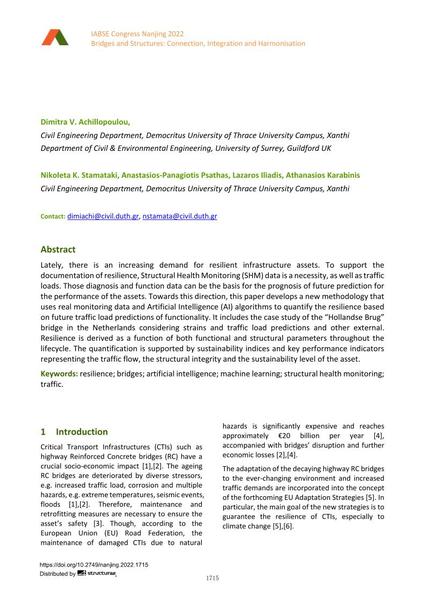Resilience Quantification Based on Monitoring & Prediction Data Using Artificial Intelligence (AI)

|
|
|||||||||||
Détails bibliographiques
| Auteur(s): |
Dimitra V. Achillopoulou
Nikoleta K. Stamataki (Civil Engineering Department, Democritus University of Thrace University Campus, Xanthi) Anastasios-Panagiotis Psathas (Civil Engineering Department, Democritus University of Thrace University Campus, Xanthi) Lazaros Iliadis (Civil Engineering Department, Democritus University of Thrace University Campus, Xanthi) Athanasios Karabinis (Civil Engineering Department, Democritus University of Thrace University Campus, Xanthi) |
||||
|---|---|---|---|---|---|
| Médium: | papier de conférence | ||||
| Langue(s): | anglais | ||||
| Conférence: | IABSE Congress: Bridges and Structures: Connection, Integration and Harmonisation, Nanjing, People's Republic of China, 21-23 September 2022 | ||||
| Publié dans: | IABSE Congress Nanjing 2022 | ||||
|
|||||
| Page(s): | 1715-1722 | ||||
| Nombre total de pages (du PDF): | 8 | ||||
| DOI: | 10.2749/nanjing.2022.1715 | ||||
| Abstrait: |
Lately, there is an increasing demand for resilient infrastructure assets. To support the documentation of resilience, Structural Health Monitoring (SHM) data is a necessity, as well as traffic loads. Those diagnosis and function data can be the basis for the prognosis of future prediction for the performance of the assets. Towards this direction, this paper develops a new methodology that uses real monitoring data and Artificial Intelligence (AI) algorithms to quantify the resilience based on future traffic load predictions of functionality. It includes the case study of the “Hollandse Brug” bridge in the Netherlands considering strains and traffic load predictions and other external. Resilience is derived as a function of both functional and structural parameters throughout the lifecycle. The quantification is supported by sustainability indices and key performance indicators representing the traffic flow, the structural integrity and the sustainability level of the asset. |
||||
| Mots-clé: |
ponts
|
||||
| Copyright: | © 2022 International Association for Bridge and Structural Engineering (IABSE) | ||||
| License: | Cette oeuvre ne peut être utilisée sans la permission de l'auteur ou détenteur des droits. |
||||
